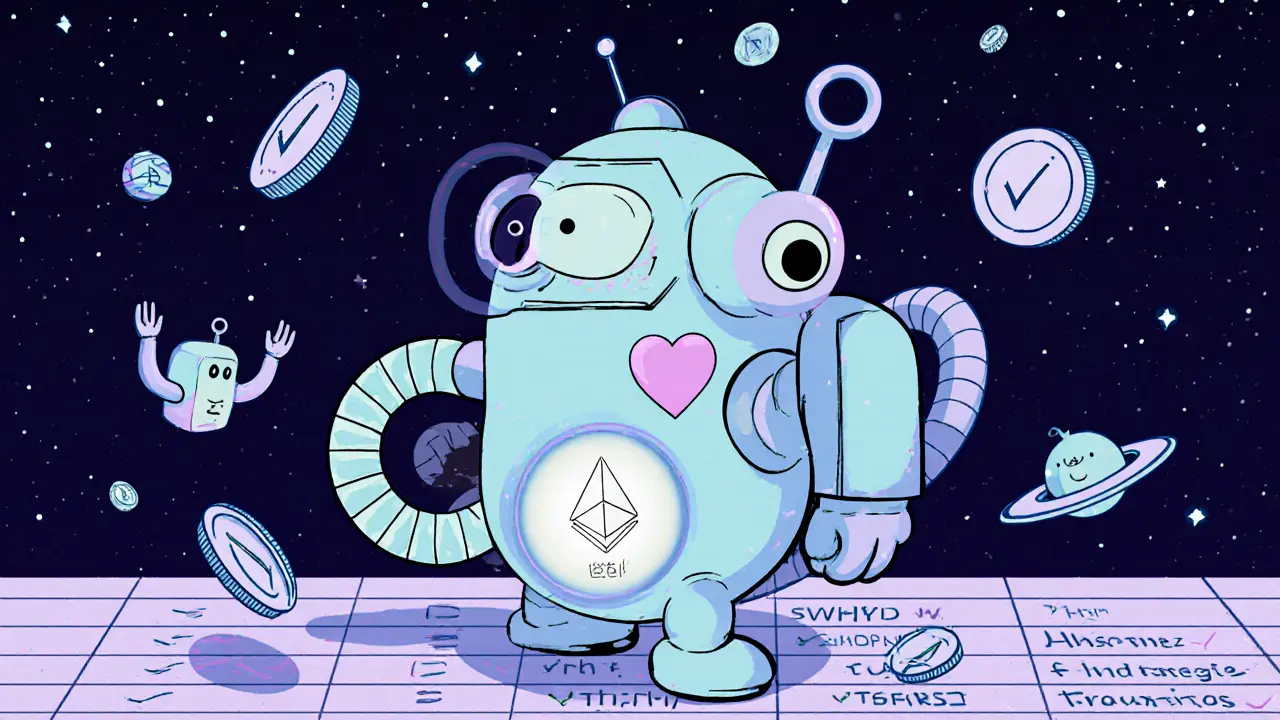What Are Validator Nodes in Blockchain? A Clear Guide to How They Secure Networks

Nov, 14 2025
Validator Rewards Calculator
Estimate Your Validator Rewards
Think of a blockchain as a digital ledger that no single person controls. Instead, it’s kept in sync by hundreds or thousands of computers scattered around the world. But who makes sure every transaction is real? That’s where validator nodes come in. They’re the ones checking transactions, building new blocks, and making sure no one cheats. Without them, blockchain wouldn’t work. And unlike the old-school mining systems, you don’t need a warehouse full of GPUs to be one.
What Exactly Does a Validator Node Do?
A validator node is a computer that participates in a blockchain’s consensus process. It doesn’t mine like Bitcoin does. Instead, it verifies transactions and helps decide which blocks get added to the chain. This happens in networks that use Proof-of-Stake (PoS), which is now the standard for most major blockchains like Ethereum, Solana, and Cardano.
Here’s what validators actually do, step by step:
- Check transactions: Every time someone sends crypto, the validator checks the digital signature, makes sure the sender has enough balance, and confirms the transaction follows the network’s rules.
- Propose new blocks: Selected validators take a group of verified transactions and bundle them into a block. They then broadcast it to the network.
- Vote on blocks: Other validators review the proposed block. If they agree it’s valid, they sign off. Once enough signatures are collected, the block is added to the chain.
- Enforce rules: If a validator tries to approve a fake transaction or double-spend coins, the network catches it-and punishes them.
This system is called consensus. It’s how thousands of strangers agree on one version of the truth without needing a bank or government in the middle.
Why Are Validator Nodes Better Than Miners?
Before PoS, blockchains like Bitcoin used Proof-of-Work (PoW). Miners competed to solve math puzzles using massive amounts of electricity. The first to solve it got the reward. It was secure-but wasteful. Bitcoin mining now uses more electricity than some countries.
Validator nodes changed all that. Instead of burning power, they lock up (or "stake") their own crypto as collateral. The more you stake, the higher your chance of being chosen to validate the next block. But here’s the catch: if you act dishonestly, you lose part of your stake. That’s called slashing.
That’s the big difference:
- Miners: Spend money on hardware and electricity. Win by brute force.
- Validators: Spend money on crypto. Win by honesty. Fail if you cheat.
It’s smarter, greener, and cheaper. Ethereum switched from mining to staking in September 2022. Since then, its energy use dropped by over 99%. Validator nodes made that possible.
How Do You Become a Validator?
You can’t just install software and start validating. Every network has rules.
On Ethereum, you need 32 ETH to run your own validator node. That’s about $100,000 USD as of late 2025. But you don’t have to put up that much yourself. Many people pool their ETH together through staking services like Lido or Coinbase. These services let you stake smaller amounts and still earn rewards.
Other networks have different thresholds:
- Solana: No fixed minimum, but you need enough SOL to be competitive. Top validators stake hundreds of thousands of dollars.
- Cardano: You can delegate as little as 1 ADA to a stake pool. You don’t need to run a node yourself.
- Radix Babylon: Only 100 validators are active at a time, chosen by how much XRD token holders delegate to them.
Running your own node also requires:
- A reliable internet connection (no drops allowed)
- Stable hardware (a basic server or even a Raspberry Pi can work on some chains)
- Basic technical skills to update software and monitor performance
- Security awareness (hacked nodes get slashed)
Most people start by delegating. It’s easier. You still earn rewards, just without the technical hassle.

What’s the Reward? And What’s the Risk?
Validators earn new tokens as a reward for doing their job. On Ethereum, annual rewards range from 3% to 6%, depending on how much total ETH is staked. On Solana, it’s closer to 5-8%. These aren’t guaranteed, but they’re steady if your node stays online.
But there’s risk.
If your validator goes offline for too long, you lose a small portion of your stake. That’s called "slashing." If you try to sign two conflicting blocks (a double-spend attempt), you lose most or all of your stake. It’s a harsh penalty-but it’s what keeps the network honest.
Some validators have lost thousands of dollars because their servers crashed or they forgot to update software. Others have been hacked because they left private keys exposed. The rewards look good, but the responsibility is real.
Who Runs These Nodes? And Why Does It Matter?
Early on, validator nodes were mostly run by crypto enthusiasts and small teams. Now, professional firms run most of them. Companies like Coinbase, Blockdaemon, and Stakehound operate hundreds of nodes across multiple chains.
This has led to a debate: Is blockchain still decentralized if a few companies control most of the validators?
On Ethereum, the top 10 validators control about 40% of the staked ETH. That’s a concern. If one of them gets hacked or goes offline, it could slow the whole network. That’s why many networks now encourage smaller validators and offer better tools for home operators.
The goal isn’t to have one giant validator. It’s to have hundreds of independent ones-spread across countries, companies, and individuals. That’s what makes blockchain resistant to censorship and control.

What’s Next for Validator Nodes?
Validator technology is still evolving. New features are being added all the time:
- Liquid staking: Lets you stake your crypto and still use it in DeFi apps. You get rewards while keeping liquidity.
- Automated slashing protection: Tools that detect when your node is about to go offline and automatically restart it.
- Multi-chain validators: One node that can validate on Ethereum, Polygon, and Arbitrum at the same time.
- Improved user interfaces: More dashboards that show your stake status, rewards, and risks in plain language.
As more people join, the system gets more secure. But it also gets more competitive. The days of easy rewards are fading. Now, you need to be smart, reliable, and informed.
Final Thoughts: Why Validator Nodes Matter
Validator nodes aren’t just tech-they’re the foundation of trust in modern blockchain. They replaced miners not because they’re cooler, but because they’re better. They’re more efficient, more secure, and more aligned with the original idea of decentralization.
Whether you’re holding crypto, using a DeFi app, or just curious about how blockchains work, validator nodes are the invisible hands keeping everything running. They don’t get headlines. But without them, your transactions wouldn’t clear. Your NFTs wouldn’t be safe. And the whole system would collapse.
They’re not perfect. They’re not easy. But they’re essential.
What’s the difference between a validator node and a full node?
A full node downloads and verifies every transaction on the blockchain, but it doesn’t participate in consensus. It just watches. A validator node does that too-but it also proposes new blocks and votes on them. Validators are active participants. Full nodes are observers. You can run a full node with no crypto. To be a validator, you must stake tokens.
Can I run a validator node on my home computer?
Yes, for some networks. Ethereum requires a dedicated machine with 16GB RAM and a fast SSD. Solana and Cardano can run on a Raspberry Pi if you’re just delegating. But if you’re running your own validator, you need reliable power, internet, and backup systems. Home setups are risky-most professional validators use cloud servers or data centers.
Do I need to be a programmer to run a validator?
Not anymore. Most networks now have one-click installers and web dashboards. You still need to understand staking, slashing, and security basics, but you don’t need to write code. If you can update your phone apps, you can manage a validator. That said, deeper technical knowledge helps you troubleshoot issues faster.
What happens if my validator gets slashed?
You lose a portion of your staked tokens. The amount depends on the network and the severity. Minor downtime might cost you 0.1% of your stake. Malicious behavior like double-signing can mean losing 100%. Most networks have a grace period for accidental downtime. Always monitor your node and set up alerts.
Are validator rewards taxable?
In most countries, yes. Validator rewards are treated as income when you receive them. If you later sell those tokens, you may owe capital gains tax. Keep records of your rewards, dates, and values. Tax software like Koinly or TokenTax can help track this automatically.
Is staking through a service safer than running my own validator?
It’s safer for beginners. Reputable staking services (like Coinbase or Kraken) have enterprise-grade security, uptime guarantees, and insurance. But you’re trusting them with your funds. If they get hacked or go offline, you could lose rewards-or even your stake. Running your own node gives you full control but more risk. Choose based on your technical comfort and risk tolerance.